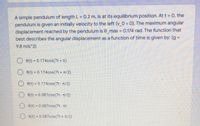Question

Transcribed Image Text:A simple pendulum of length L = 0.2 m, is at its equilibrium position. At t = 0, the
pendulum is given an initially velocity to the left (v_0 < 0). The maximum angular
displacement reached by the pendulum is e_max = 0.174 rad. The function that
best describes the angular displacement as a function of time is given by: (g =
%3D
9.8 m/s^2)
O e(t) = 0.174cos(7t + n)
O e(t) = 0.174cos(7t + T/2)
8(t) = 0.174cos(7t- n/2)
%3D
8(t) = 0.087cos(7t- T/2)
O e(t) = 0.087cos(7t - Tt)
O 6(t) = 0.087cos(7t + n/2)
Expert Solution
This question has been solved!
Explore an expertly crafted, step-by-step solution for a thorough understanding of key concepts.
Step by stepSolved in 4 steps

Knowledge Booster
Similar questions
- In the figure, a solid cylinder attached to a horizontal spring (k = 5.80 N/m) rolls without slipping along a horizontal surface. If the system is released from rest when the spring is stretched by 0.290 m, find (a) the translational kinetic energy and (b) the rotational kinetic energy of the cylinder as it passes through the equilibrium position. (c) If the cylinder has mass M = 6.20 kg, find the period of the simple harmonic motion that the cylinder's center of mass executes. (Hint: Find the time derivative of the total mechanical energy.) M · k oooooo (a) Number i 0. (b) Number i (c) Number i O. Units Units Unitsarrow_forwardYou have made a physical pendulum by swinging a rod of mass M = 1.08 kg and length L = 1.45 meters around its end. The mass of the rod is distributed uniformly along its length. We will assume that the amplitude of the swing is max = 19.34 degrees. Solid Rod Swings in Simple Harmonic Motion ^ 0=-0, max 0=+0₁ max Determine all the following: The FORMULA for the moment of inertia of your rod, I = The distance from the pivot point to the Center-Of-Mass, d = The angular frequency of the pendulum, w = The amplitude of the motion in radians, max = radians The angular velocity when 0 = 64% of full swing, w(0 = 0.64 0max): NOTE: The first question requires a FORMULA, not a value. rad/sec = meters rad/secarrow_forwardA simple pendulum comprised of a bob of mass m = 172 g and a lightweight string of length 76.0 cm is released from rest from an initial angle of 28.0° from the vertical. (a) Using the approach of simple harmonic motion, what is the maximum speed of the pendulum bob? m/s(b) Using the approach of simple harmonic motion, what is the maximum angular acceleration of the bob? rad/s2(c) How does the speed found in part (a) compare with that found by using a conservation of energy approach? (Assume that the values are nearly the same if within 10% of each other.) The speed is very different from that from part (a). The speed is nearly the same as that from part (a).arrow_forward
- A thin uniform rod (mass = 0.24 kg) swings about an axis that passes through one end of the rod and is perpendicular to the plane of the swing. The rod swings with a period of 1.1 s and an angular amplitude of 9.6°. (a) What is the length of the rod? (a) What is the maximum kinetic energy of the rod as it swings?arrow_forwardA coin having a mass of m = 12 g, a thickness of h = 0.17 cm, and a radius of r = 1.5 cm has a small hole drilled through it so that it can be suspended from a thin wire and worn as an earring or pendant. The hole is at a distance of 7/8 r from the center of the coin as shown above. When suspended from this hole, the coin is a physical pendulum that swings back and forth with this hole as its axis of rotation. Assuming that the hole does not appreciably change the center of mass of the coin, determine the period of this physical pendulum.arrow_forwardThe pendulum in the figure consists of a uniform disk with radius r = 10.0 cm and mass 560 g attached to a uniform rod with length L = 390 mm and mass 270 g. (a) Calculate the rotational inertia of the pendulum about the pivot point. (b) What is the distance between the pivot point and the center of mass of the pendulum? (c) Calculate the period of oscillation. (a) Number Units (b) Number i Units (c) Number i Unitsarrow_forward
arrow_back_ios
arrow_forward_ios